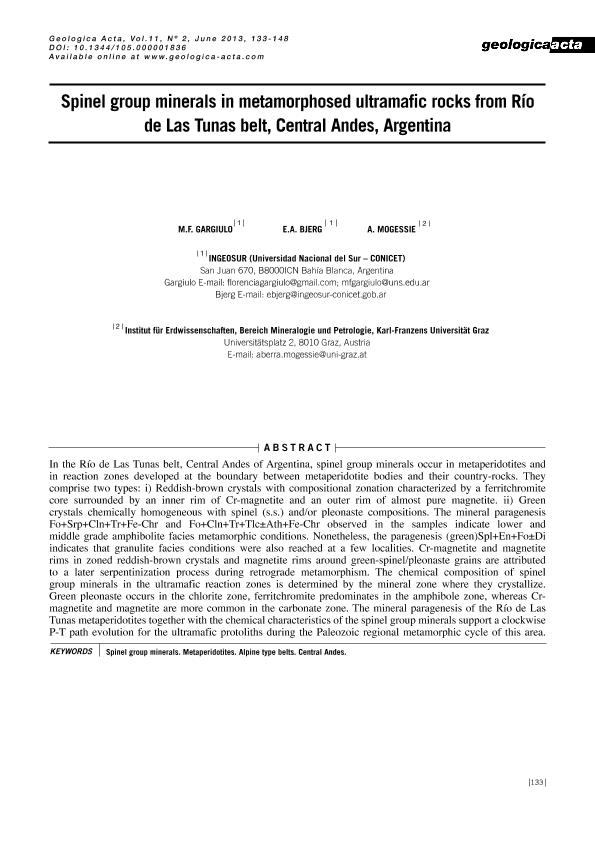Artículo
Spinel group minerals in metamorphosed ultramafic rocks from Río de Las Tunas Belt, Central Andes, Argentina
Fecha de publicación:
06/2013
Editorial:
Universidad de Barcelona
Revista:
Geologica Acta
ISSN:
1695-6133
Idioma:
Inglés
Tipo de recurso:
Artículo publicado
Clasificación temática:
Resumen
In the Río de Las Tunas belt, Central Andes of Argentina, spinel group minerals occur in metaperidotites and in reaction zones developed at the boundary between metaperidotite bodies and their country-rocks. They comprise two types: i) Reddish-brown crystals with compositional zonation characterized by a ferritchromite core surrounded by an inner rim of Cr-magnetite and an outer rim of almost pure magnetite. ii) Green crystals chemically homogeneous with spinel (s.s.) and/or pleonaste compositions. The mineral paragenesis Fo+Srp+Cln+Tr+Fe-Chr and Fo+Cln+Tr+Tlc±Ath+Fe-Chr observed in the samples indicate lower and middle grade amphibolite facies metamorphic conditions. Nonetheless, the paragenesis (green)Spl+En+Fo±Di indicates that granulite facies conditions were also reached at a few localities. Cr-magnetite and magnetite rims in zoned reddish-brown crystals and magnetite rims around green-spinel/pleonaste grains are attributed to a later serpentinization process during retrograde metamorphism. The chemical composition of spinel group minerals in the ultramafic reaction zones is determined by the mineral zone where they crystallize. Green pleonaste occurs in the chlorite zone, ferritchromite predominates in the amphibole zone, whereas Cr-magnetite and magnetite are more common in the carbonate zone. The mineral paragenesis of the Río de Las Tunas metaperidotites together with the chemical characteristics of the spinel group minerals support a clockwise P-T path evolution for the ultramafic protoliths during the Paleozoic regional metamorphic cycle of this area.
Palabras clave:
Spinel Group Minerals
,
Metaperidotites
,
Alpine Type Belts
,
Central Andes
Archivos asociados
Licencia
Identificadores
Colecciones
Articulos(INGEOSUR)
Articulos de INST.GEOLOGICO DEL SUR
Articulos de INST.GEOLOGICO DEL SUR
Articulos(SEDE CENTRAL)
Articulos de SEDE CENTRAL
Articulos de SEDE CENTRAL
Citación
Gargiulo, Maria Florencia; Bjerg, Ernesto Alfredo; Mogessie, A.; Spinel group minerals in metamorphosed ultramafic rocks from Río de Las Tunas Belt, Central Andes, Argentina; Universidad de Barcelona; Geologica Acta; 11; 2; 6-2013; 133-148
Compartir
Altmétricas




